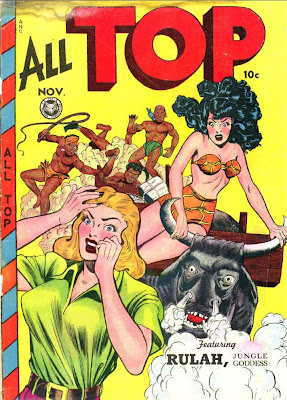 Detective Comics #391 (On Sale: July 31, 1969) has a cover by Neal Adams.
Detective Comics #391 (On Sale: July 31, 1969) has a cover by Neal Adams.We begin with Batman in "The Gal Most Likely to Be -- Batman's Widow" by Frank Robbins, Bob Brown and Joe Giella. Tim Clark a masseuse and physical therapist at Bruce Wayne's club is having problems with his girlfriend, Ginny Jenkins (from Detective Comics #380). She has started working for Mr. Arnold at Dining Out Magazine. Through an accidentally turned on intercom Tim and Bruce learn that Mr. Arnold is using the magazine to extort advertising money out of restaurants. While Bruce leaves to change into Batman, Tim learns of Ginny's inadvertent involvement in the plan, as she is the magazine's reviewer.
That night at a restaurant being visited by Mr. Arnold and Ginny, two good threaten to ruin the food if the owner does not buy an expensive ad. the plot is broken up by Batman, but the owner refuses to finger Arnold as the instigator. that night Tim tries to warn Ginny that Arnold is a crook, but Ginny just thinks he is jealous and won't listen to him. Tim thinks she would listen if Batman was the one telling her and then hatches a plan.
Arnold meets his henchmen in the sauna at the club once again and gives them the orders for tonight's restaurant attack. When they leave Batman is seen leaving the building and an unseen person removes a bar of soap from the sauna. At tonight's restaurant, the owner is prepared to pay the extortion money when Batman comes to him with a plan. Shortly the waiter brings Arnold and Ginny a souvenir of the restaurant, only Batman shows up and reveals that the small models actually contain the pay-off money. Arnold pulls a gun, but Batman knocks him out and then comforts Ginny.
Arnold comes to and calls for his men who sneak up on Batman and knock him out. Before they throw him off the balcony to his death they unmask Batman and find that he is Tim Clark. Only the real Batman shows up at that time and mops up the gang, reveals that the money they were given was marked by the owner and also reveals a small tape recorder hidden in a bar of soap that Batman used to gather evidence against Arnold and his men.
The back-up Robin story is "Strike" by Mike Friedrich, Gil Kane and Murphy Anderson and continues from last issue. Personally, I thought last issue was a pretty much jumbled mess and this issue doesn't really do much to rectify that feeling.I never liked the Friedrich Robin stories, they never rang true for me, though he sure wrote a lot of them in his five years at DC.
The head negotiator for the college has abruptly ended negotiations with the Teachers' Union. Dick Grayson and Gotham Owl editor Rocky follow the negotiator and see him talking to two kids wearing Skyline jackets, one of whom Dick recognizes as the one that got away from the skirmish Friday night.
Rocky leaves and Dick is free to change into Robin and after a relatively quick fight the head negotiator tells how he was blackmailed into ending negotiations and that someone had tried to run over his son. One of the Skyline kids tells Robin who their boss is, where to find him and what type of protection he has.
Robin quickly foots it to the bosses HQ, and knock out the two guards he was warned about outside the building. He then races into the big man's office only to find two more gunsels that he knew nothing about. Robin realizes he has been set up , but as the thugs prepare to blast him, the police call out over a loudspeaker for the thugs to surrender with their hands up. Robin uses the momentary distraction to take out the two thugs and the big boss. When he calls for the police to come in and take them all away he finds that it was only Rocky, who had followed Robin to the thugs hideout.
It ends up the big boss owned land adjacent to the college and wanted to make sure that his land was used for the campus expansion. Later the negotiations are begun again and a new contract is quickly signed. This story was reprinted in Batman in the Sixties TPB and Showcase Presents: Robin the Boy Wonder Vol. 1 TPB.
Edited by Julius Schwartz.






























